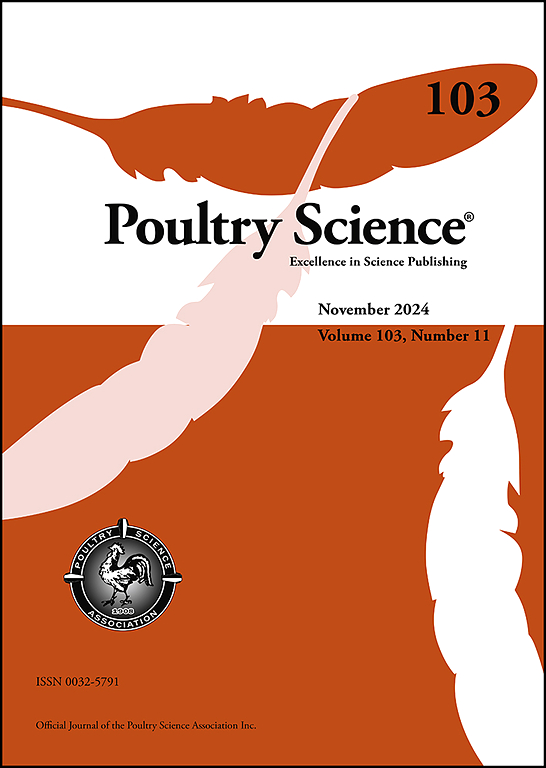基于16S rRNA基因测序和代谢组学的山马鸭产蛋微生物及代谢物研究
IF 4.2
1区 农林科学
Q1 AGRICULTURE, DAIRY & ANIMAL SCIENCE
引用次数: 0
摘要
肠道菌群和代谢产物在调节家禽健康、代谢和产蛋性能中起着至关重要的作用。为了阐明产蛋性能差异的生物学基础,本研究采用16S rRNA高通量测序和非靶向液相色谱-质谱联用技术(LC-MS/MS)对低产量山马鸭(LP)和高产量山马鸭(HP)的肠道微生物群和血清代谢组进行了分析。低脂组和高脂组在产蛋性能、体尺参数和屠宰性状上均有显著差异。厚壁菌门是两组肠道菌群的优势门。然而,放线菌在HP组中显著富集,弯曲杆菌在LP组中更为丰富。相关分析显示弯曲杆菌丰度与产蛋量呈负相关,而杆状杆菌(放线菌属)丰度与产蛋量呈正相关。非靶向血清代谢组学分析表明,差异表达的代谢物主要富集于核苷酸代谢、胆碱代谢和甘油磷脂代谢途径。值得注意的是,弯曲杆菌的丰度与参与这些途径的关键代谢物的水平呈负相关。Mantel分析进一步证实了产蛋量与肠道微生物群组成和血清代谢组学特征之间的密切相关。总之,这些发现为鸭繁殖性能的微生物和代谢决定因素提供了新的见解,为遗传选择和针对微生物群的营养策略提供了基础,以提高山马鸭的产蛋效率。本文章由计算机程序翻译,如有差异,请以英文原文为准。
Exploration of microorganism and metabolites relation to the egg production of Shanma ducks based on 16S rRNA gene sequencing and metabolomics
Gut microbiota and metabolites play crucial roles in regulating poultry health, metabolism, and egg-laying performance. To elucidate the biological basis underlying differences in laying performance, this study employed 16S rRNA high-throughput sequencing and untargeted liquid chromatography-mass spectrometry (LC-MS/MS) to analyze the gut microbiota and serum metabolome of low-producing (LP) and high-producing (HP) Shanma ducks. The LP and HP groups exhibited significant differences in egg production performance, body size parameters, and slaughter traits. Firmicutes were the dominant phylum in the gut microbiota of both groups. However, Actinobacteria were significantly enriched in the HP group, while Campylobacter was more abundant in the LP group. Correlation analysis revealed a negative association between Campylobacter abundance and egg production, whereas Corynebacterium (belonging to Actinobacteria) showed a positive correlation. Non-targeted serum metabolomic analysis indicated that the differentially expressed metabolites were primarily enriched in nucleotide metabolism, choline metabolism, and glycerophospholipid metabolism pathways. Notably, Campylobacter abundance was negatively correlated with the levels of key metabolites involved in these pathways. Mantel analysis further confirmed a strong correlation between egg production and both gut microbiota composition and serum metabolomic profiles. Collectively, these findings provide new insights into the microbial and metabolic determinants of reproductive performance in ducks, offering a foundation for genetic selection and microbiota-targeted nutritional strategies to enhance laying efficiency in Shanma ducks.
求助全文
通过发布文献求助,成功后即可免费获取论文全文。
去求助
来源期刊

Poultry Science
农林科学-奶制品与动物科学
CiteScore
7.60
自引率
15.90%
发文量
0
审稿时长
94 days
期刊介绍:
First self-published in 1921, Poultry Science is an internationally renowned monthly journal, known as the authoritative source for a broad range of poultry information and high-caliber research. The journal plays a pivotal role in the dissemination of preeminent poultry-related knowledge across all disciplines. As of January 2020, Poultry Science will become an Open Access journal with no subscription charges, meaning authors who publish here can make their research immediately, permanently, and freely accessible worldwide while retaining copyright to their work. Papers submitted for publication after October 1, 2019 will be published as Open Access papers.
An international journal, Poultry Science publishes original papers, research notes, symposium papers, and reviews of basic science as applied to poultry. This authoritative source of poultry information is consistently ranked by ISI Impact Factor as one of the top 10 agriculture, dairy and animal science journals to deliver high-caliber research. Currently it is the highest-ranked (by Impact Factor and Eigenfactor) journal dedicated to publishing poultry research. Subject areas include breeding, genetics, education, production, management, environment, health, behavior, welfare, immunology, molecular biology, metabolism, nutrition, physiology, reproduction, processing, and products.
 求助内容:
求助内容: 应助结果提醒方式:
应助结果提醒方式:


